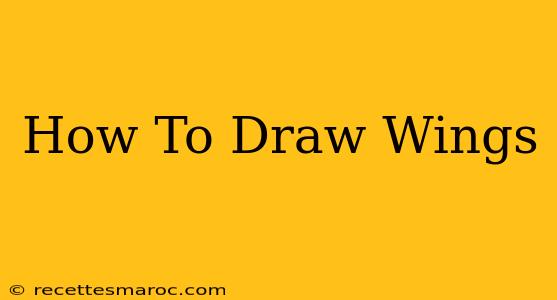Want to add a touch of flight and fantasy to your artwork? Learning how to draw wings is a rewarding skill that opens up a world of creative possibilities, from majestic angels to graceful birds. This comprehensive guide will walk you through the process, offering tips and techniques for both beginners and those looking to refine their skills.
Understanding Wing Anatomy: The Foundation of Realistic Wings
Before you start sketching, understanding the basic anatomy of wings is crucial, regardless of whether you're aiming for realism or a more stylized approach. Different creatures have different wing structures.
Bird Wings:
- Shape and Structure: Observe the streamlined shape, the leading edge (the front of the wing), and the trailing edge (the back). Notice how the feathers overlap and create a smooth surface for efficient flight.
- Primary and Secondary Feathers: Primary feathers are long and situated on the outer part of the wing, responsible for lift and thrust. Secondary feathers are shorter and closer to the body, providing stability. Pay attention to how these feathers vary in length and curvature.
- Wingspan and Aspect Ratio: The wingspan is the total distance between the wingtips. The aspect ratio (wingspan divided by wing chord – the average width of the wing) determines the wing's shape and influences flight characteristics. A high aspect ratio means long, narrow wings, ideal for soaring. A low aspect ratio means shorter, broader wings, suited for maneuverability.
Other Winged Creatures:
- Insect Wings: These are generally more delicate and membrane-like, often with intricate venation (veins). Focus on the transparency and delicate structure.
- Mythical Wings (Angels, Dragons, etc.): These offer more creative freedom. You can use bird wing anatomy as a base, but feel free to add embellishments, fantastical details, and unique shapes.
Step-by-Step Guide to Drawing Wings:
This guide focuses on drawing bird-like wings, but the principles can be adapted to other types of wings.
Step 1: Basic Wing Shape:
Start with a simple outline. You can use a slightly curved line to represent the leading edge and another slightly curved line for the trailing edge. Connect these lines at the base of the wing and the wingtip. Consider the aspect ratio you want to achieve.
Step 2: Adding the Primary Feathers:
Draw long, slightly curved lines extending from the leading edge to the trailing edge, representing the primary feathers. Vary the length of these feathers to create a natural look. Remember that the feathers typically overlap slightly.
Step 3: Adding Secondary Feathers:
Beneath the primary feathers, add shorter, more curved lines to represent the secondary feathers. These feathers should be closer together than the primary feathers.
Step 4: Refining the Details:
Now, add more details to the feathers. You can sketch individual feather barbs for a more realistic look or keep it simpler by just suggesting the shape and texture of the feathers.
Step 5: Adding Texture and Shading:
Use shading and highlighting to create depth and dimension. This will help your wings look more realistic and three-dimensional. Consider the direction of the light source when applying shading.
Tips and Tricks for Drawing Wings:
- Use References: Look at photographs and illustrations of real wings. Observing nature is invaluable.
- Practice Different Perspectives: Try drawing wings from different angles to understand how they change shape.
- Experiment with Styles: Don't be afraid to experiment with different styles, from realistic to cartoonish.
- Start Simple, Build Up Complexity: Begin with basic shapes and gradually add more details.
- Embrace Imperfection: Don't worry about making mistakes. Learning comes from practice and experimentation.
Beyond the Basics: Exploring Different Wing Styles
Once you've mastered the basics, explore various wing styles:
- Feathery Wings: Focus on individual feathers and their texture.
- Membranous Wings (like Bats): Emphasize the skin-like texture and the veins.
- Stylized Wings: Use geometric shapes or abstract designs.
- Mythological Wings: Incorporate fantasy elements and unique characteristics.
Mastering the art of drawing wings is a journey, not a destination. With consistent practice and a keen eye for observation, you'll soon be creating breathtaking winged creations. So grab your pencils and unleash your creativity!

